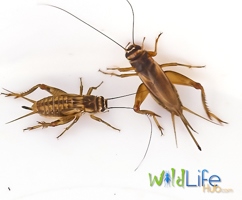Making Crickets Live Longer and Healthier
We all have been there … you just bought a container of expensive crickets and half of them were dead or dying. Now your wondering why you paid for them, and why is it so difficult to keep them alive? Why are my crickets dying?
We discuss the three most common reasons crickets die and give you solutions so you don’t waste your money.
At the heart of the problem is the crickets short or “fast and furious” life cycle. Crickets are commercially produced at high temperatures, which reduces their life cycle to around 6-7 weeks. This is not long when you consider they become adults in around 4 or 5 weeks.
This means that an adult cricket is nearing the end of its life cycle when you receive it, and may only have a week or two before dying. This is why it is much harder to keep adult crickets alive than small and medium sizes. Here are some tips to reduce deaths:
- If you plan to keep large crickets for a week or two, you may be better off buying medium sized crickets which live longer. In most cases medium crickets will be large in a week or two anyway. In the adjoining photo the female cricket on the left is a medium cricket (no wings, small ovipositor or spike on end of body) and a large cricket is on the right (wings and pronounced ovipositor at the end of body).
- If you plan to buy bulk quantities, split the order into small, medium and larges. In this way, you can progressively use each size as they mature without them dying.
2) Transport
Once a cricket leaves the breeding facility, it is common for them to be in transit or in the pet shop for a week or more. Given what we learned above, this means that an adult cricket may have as little as a few days or a week before it starts to die!! And that is assuming they were sent immediately after they reached adult size.
Crickets live alone in the wild so placing 35 or more adult crickets into a small container (much larger numbers for mediums and smalls) often results in cannibalism, unhygienic conditions or starvation. Here are some tips to reduce deaths:
- Here at WildlifeHub we have been producing feeder insects commercially for over a decade, and place our crickets in breathable calico bags with egg cartons and large pieces of carrot for local customers. The bags are returned when they pick up the next order. If you have a lot of crickets you need to transport for extended periods, we recommend transferring them to calico bags.
- Crickets that are bred at home will always live longer and be more nutritional as they have no transport and storage issues, and constant access to good food/water supplies. Crickets used to be one of the hardest species of insects to breed, however new methods now makes them one of the easiest.
Visit the “How to Start Breeding Crickets” page for more details.
3) Husbandry
When you get your crickets home, they require good ventilation, lots of room to move about, moderate to high temperatures and constant access to food and water. Ventilation prevents toxic gases produced by fermenting foods and poo, from killing your crickets. Crickets will eat each other if they do not have sufficient cover to escape from each other, or enough food and water. Most cricket species are tropical and require moderate to high temperatures (within 20-35 degrees Celsius or 68-95 Fahrenheit) to stay healthy. Here are some tips to reduce deaths:
- On the way home from the pet store, don’t leave them in a hot car or expose them to extreme temperatures.
- Keep them at a moderate temperature (15-20 degrees Celsius or 59-68 Fahrenheit), to slow down their development.
- Take them out of their transport container and place them into a large container with plenty of food, water, ventilation and egg cartons for protection. Our feeder insect books outline a number of techniques to feed crickets to your animals, and how to build a temporary container that; houses the crickets when they get home; filters them into different sizes (if necessary); removes poo easily; and dusts them with vitamin powder.
- Provide a gut loading mixture (nutrient rich food) and a plentiful supply of water so that they maintain health and vitality.
If you need any further information on keeping or breeding feeder insects visit our Feeder Insect page or get our Free Cricket Breeding Training Course.

